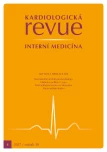Myocardial ischaemia and infarction in intraventricular conduction malfunctions on ECG
Authors:
D. Pospíšil; M. Sepši; M. Kozák
Authors‘ workplace:
Interní kardiologická klinika LF MU a FN Brno
Published in:
Kardiol Rev Int Med 2017, 19(4): 251-260
Overview
Malfunction of the electrical conduction system of the heart can make it difficult or impossible to recognise ischaemia or myocardial infarction. The most problematic ones are left intraventricular blocks, e.g. left bundle branch block or left anterior hemiblock, which disallow the development of pathological Q wave. If the conduction block is secondary to acute ischaemia, we call it an acquired block, which is associated with massive muscle damage. On the other hand, pre-existing blocks do not affect the prognosis, although they are quite frequent. It is important to monitor the patient’s clinical and laboratory status and to assess ST-T changes over time. Acute ischaemia can also be imitated or masked by the existence of an accessory pathway with prograde conduction or by ventricular pacing with an implantable device.
Key words:
electrocardiogram – ECG – heart conduction system – bundle branch block, ischaemia, myocardial infarction
Sources
1. Táborský M, Kautzner J, Linhart A et al. Kardiologie. Praha: Mladá fronta 2017.
2. Strauss DG, Selvester RH, Wagner GS. Defining left bundle branch block in the era of cardiac resynchronization therapy. Am J Cardiol 2011; 107(6): 927– 934. doi: 10.1016/ j.amjcard.2010.11.010.
3. Surawicz B, Childers R, Deal BJ et al. AHA/ ACCF/ HRS Recommendations for the Standardization and Interpretation of the Electrocardiogram: Part III: intraventricular conduction disturbances: a scientific statement from the American Heart Association Electrocardiography and Arrhythmias Committee, Council on Clinical Cardiology; the American College of Cardiology Foundation; and the Heart Rhythm Society: endorsed by the International Society for Computerized Electrocardiology. Circulation 2009; 119(10): e235– e240. doi: 10.1161/ CIRCULATIONAHA.108.191095.
4. Thygesen K, Alpert JS, Jaffe AS et al. Third universal definition of myocardial infarction. Eur Heart J 2012; 33(20): 2551– 2567. doi: 10.1093/ eurheartj/ ehs184.
5. Aschermann M, Widimský P, Veselka J et al. Kardiologie. Praha: Galén 2004.
6. Wellens HJ, Conover M. The ECG in emergency decision making. 2nd ed. St. Louis: Saunders Elsevier 2006.
7. Štejfa M, Šumbera J, Bravený P. Základy elektrokardiografie. Brno: Masarykova univerzita, Lékařské fakulta 1991.
8. Sgarbossa EB, Pinski SL, Barbagelata A et al. Electrocardiographic diagnosis of evolving acute myocardial infarction in the presence of left bundle-branch block. N Engl J Med 1996; 334(8): 481– 487. doi: 10.1056/ NEJM199602223340801.
9. Shlipak MG, Lyons WL, Go AS et al. Should the electrocardiogram be used to guide therapy for patients with left bundle-branch block and suspected myocardial infarction? JAMA 1999; 281(8): 714. doi: 10.1001/ jama.281.8.714.
10. Gula LJ, Dick A, Massel D. Diagnosing acute myocardial infarction in the setting of left bundle branch block: prevalence and observer variability from a large community study. Coron Artery Dis 2003; 14(5): 387– 393. doi: 10.1097/ 01.mca.0000085135.16622.e8.
11. Rosenbaum MB, Blanco HH, Elizari MV et al. Electrotonic modulation of the T wave and cardiac memory. Am J Cardiol 1982; 50(2): 213– 222. doi: 10.1016/ 0002-9149(82)90169-2.
Labels
Paediatric cardiology Internal medicine Cardiac surgery CardiologyArticle was published in
Cardiology Review

2017 Issue 4
Most read in this issue
- Myocardial ischaemia and infarction in intraventricular conduction malfunctions on ECG
- Current fixed antihypertensive two-drug combinations in Slovakia
- Modern pharmacologic treatment of type 2 diabetes mellitus
- Acute renal failure
